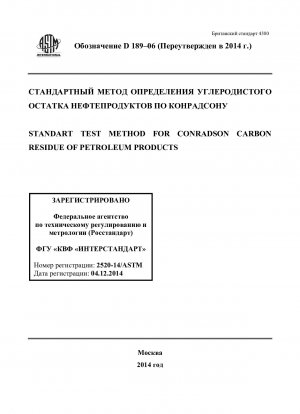ASTM D189-06(2014)
Standard Test Method for Conradson Carbon Residue of Petroleum Products
- Standard No.
- ASTM D189-06(2014)
- Release Date
- 2006
- Published By
- American Society for Testing and Materials (ASTM)
- Status
- Replace By
- ASTM D189-06(2019)
- Latest
- ASTM D189-06(2019)
- Scope
5.1 The carbon residue value of burner fuel serves as a rough approximation of the tendency of the fuel to form deposits in vaporizing pot-type and sleeve-type burners. Similarly, provided alkyl nitrates are absent (or if present, provided the test is performed on the base fuel without additive) the carbon residue of diesel fuel correlates approximately with combustion chamber deposits.
5.2 The carbon residue value of motor oil, while at one time regarded as indicative of the amount of carbonaceous deposits a motor oil would form in the combustion chamber of an engine, is now considered to be of doubtful significance due to the presence of additives in many oils. For example, an ash-forming detergent additive may increase the carbon residue value of an oil yet will generally reduce its tendency to form deposits.
5.3 The carbon residue value of gas oil is useful as a guide in the manufacture of gas from gas oil, while carbon residue values of crude oil residuums, cylinder and bright stocks, are useful in the manufacture of lubricants.
1.1 This test method covers the determination of the amount of carbon residue (Note 1) left after evaporation and pyrolysis of an oil, and is intended to provide some indication of relative coke-forming propensities. This test method is generally applicable to relatively nonvolatile petroleum products which partially decompose on distillation at atmospheric pressure. Petroleum products containing ash-forming constituents as determined by Test Method D482 or IP Method 4 will have an erroneously high carbon residue, depending upon the amount of ash formed (Note 2 and Note 4).
Note 1: The term carbon residue is used throughout this test method to designate the carbonaceous residue formed after evaporation and pyrolysis of a petroleum product under the conditions specified in this test method. The residue is not composed entirely of carbon, but is a coke which can be further changed by pyrolysis. The term carbon residue is continued in this test method only in deference to its wide common usage.
Note 2: Values obtained by this test method are not numerically the same as those obtained by Test Method D524. Approximate correlations have been derived (see Fig. X1.1), but need not apply to all materials which can be tested because the carbon residue test is applied to a wide variety of petroleum products.
Note 3: The test results are equivalent to Test Method D4530, (see Fig. X1.2).
Note 4: In diesel fue......
ASTM D189-06(2014) Referenced Document
- ASTM D4046 Standard Test Method for Alkyl Nitrate in Diesel Fuels by Spectrophotometry
- ASTM D4057 Standard Practice for Manual Sampling of Petroleum and Petroleum Products
- ASTM D4175 Standard Terminology Relating to Petroleum Products, Liquid Fuels, and Lubricants
- ASTM D4177 Standard Practice for Automatic Sampling of Petroleum and Petroleum Products
- ASTM D4530 Standard Test Method for Determination of Carbon Residue (Micro Method)
- ASTM D482 Standard Test Method for Ash from Petroleum Products
- ASTM D524 Standard Test Method for Ramsbottom Carbon Residue of Petroleum Products
ASTM D189-06(2014) history
- 2019 ASTM D189-06(2019) Standard Test Method for Conradson Carbon Residue of Petroleum Products
- 2006 ASTM D189-06(2014) Standard Test Method for Conradson Carbon Residue of Petroleum Products
- 2006 ASTM D189-06(2010)e1 Standard Test Method for Conradson Carbon Residue of Petroleum Products
- 2006 ASTM D189-06e2 Standard Test Method for Conradson Carbon Residue of Petroleum Products
- 2006 ASTM D189-06e1 Standard Test Method for Conradson Carbon Residue of Petroleum Products
- 2006 ASTM D189-06 Standard Test Method for Conradson Carbon Residue of Petroleum Products
- 2005 ASTM D189-05 Standard Test Method for Conradson Carbon Residue of Petroleum Products
- 2001 ASTM D189-01 Standard Test Method for Conradson Carbon Residue of Petroleum Products
- 1997 ASTM D189-97 Standard Test Method for Conradson Carbon Residue of Petroleum Products

Copyright ©2024 All Rights Reserved